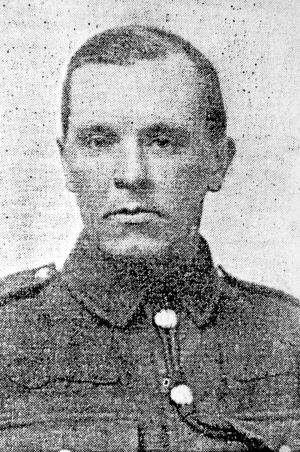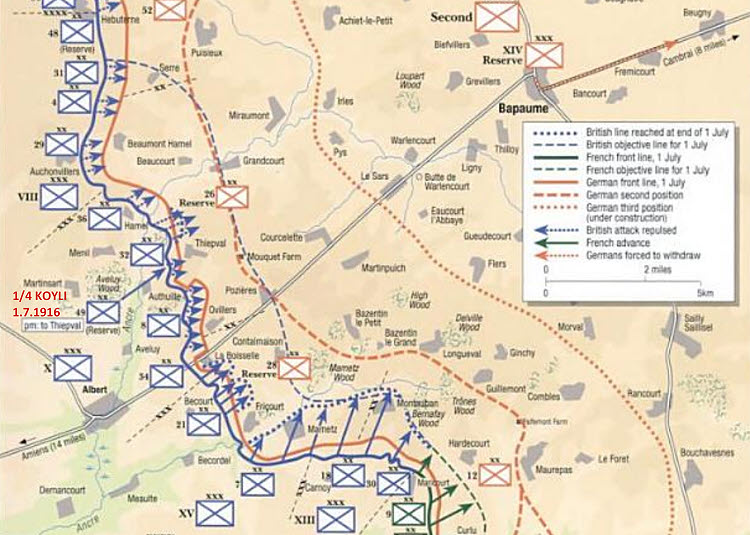
John Gray was born in 1889, in Normanton, the son of William Gray and Agnes (nee Patrick) who married in 1875. In 1901 the Gray family are living at Glass Houghton where William is working as a miner. They have three children, Miranda (15), John (13) and William (2).
In 1911, John William Gray was living on Wilson Row, Ossett with his wife Mabel (nee Illingworth) and their son, Joseph aged 2 months. John William Gray (21), a miner, married Mabel Illingworth (23) at Ossett Holy Trinity Parish Church on the 13th August 1910. The addresses of the bride and bridegroom were recorded as Old School Street, Ossett. Each had a father named William and both were miners. In 1911, John Gray was working as a “miner/filler at pit bottom.” He probably attested for army service at the start of the war in August 1914.
1/4th Battalion of KOYLI was formed in August 1914 at Wakefield as a part of the 3rd West Riding Brigade, West Riding Division. They moved on mobilisation to Doncaster and then in November 1914 to Gainsborough. They then moved on to York in February 1915. After arriving in France the battalion formation became 148th Brigade, 49th (West Riding) Division on the 15th May 1915. The 49th (West Riding) Division was part of X Corps of the British Fourth Army at the Battle of the Somme, which opened on the 1st of July 1916.
The “Ossett Observer” 1 had this report: “His Pal’s Tribute – Ossett Soldier Who A Died a Heroic Death”
“The death of Sergeant John William Gray of the local battalion of the K.O.Y.L.I. is now officially confirmed, his widow, who lives in Town-end, having received a War Office notification that he was killed in action between the 1st and 8th of this month. Sergeant-Major Barraclough, in a letter to Mrs. Gray, gives the date as the 4th inst., and he says ‘I cannot express the regret that is felt by all ranks, from his company commander to the last-joined man. His smiling face and jolly ways will be missed by us all, and I myself have lost on the best friends and also one of my best sergeants. You have the satisfaction of knowing that your husband died an instantaneous and heroic death, like the soldier that he was, and that he was never afraid of doing his duty. He was buried in a small burial ground just behind where he fell. Mr. Bell, our present company officer, wishes to express his regret at the loss of such a sergeant, also the sergeants of the company’.”
Sergeant Gray’s 1st/4th (Territorial Force) 148th Brigade, 49th (West Riding) Division made these movements up to the date of his death, aged 27, on the 4th July 1916 2:
Sergeant Gray’s army service record has not survived but his medal card records that J.W. Gray, Yorks L. I., Sgt. 1477 embarked for France on the 13th April 1915 and therefore he qualified for the 1915 Star Medal plus the British and Victory Medals. His given address at the time of his death was Old School Street, Ossett.

Above: Position of 1st/4th Battalion, KOYLI as part of 49 (West Riding) Division on the opening day of the Battle of the Somme before Sergeant Gray moved to the front line and his death on the 4th July 1916.
Sergeant John W. Gray is buried in Authuile Military Cemetery 3, Somme, France at grave reference E30. Authuile (now Authuille), is a village 5 Kms north of Albert. Authuile Military Cemetery is on the south side of the village. The Cemetery is signposted on the main road (D159) through the village.
The village was held by British troops from the summer of 1915 to March, 1918, when it was captured in the German Offensive on the Somme; it was ruined by shell fire even before that date. The Military Cemetery was used by Field Ambulances and fighting units from August, 1915 to December, 1916, and in 1917 and 1918 by Indian Labour Companies. There are now over 450, 1914-18 war casualties commemorated in this site. Of these, nearly 40 are unidentified and special memorials are erected to 18 soldiers from the United Kingdom, known or believed to be buried among them. The graves of two other German soldiers have been removed.

Commonwealth War Graves Commission Headstone (Photograph courtesy of Mark Smith)
References:
1. “Ossett Observer”, 29th July 1916
2. “British Battalions on the Somme.” by Ray Westlake, Pen & Sword Books Ltd; 1st Edition edition (June 1994)